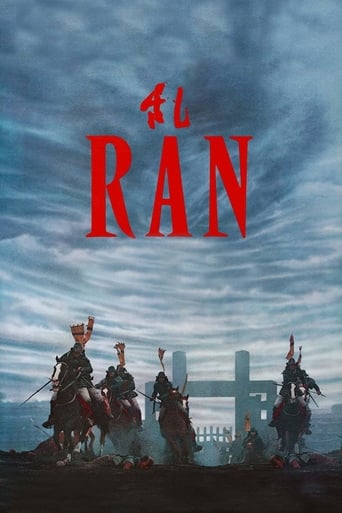sir-mauri
An absolute masterwork, the human being's dark sides as the main protagonists. Vengeance, hatred, betrayal, greed and what they bring with themselves. It's the deepest film that I've seen so far on Kurosawa's filmography. Visually beautiful, pure poetry in every frame and every death. There is strong symbolism on the red color and the fire. The history of humanity has been covered by blood and fueled with greed since the very beginning, among these beautiful landscapes, the human race have been destroying themselves no matter the family bond or friendship. Not only Kurosawa's best, but also the best film adaptation of Shakespeare.
Leofwine_draca
This was my fourth Kurosawa film and my favourite to date. Previously, I'd started off by watching SEVEN SAMURAI (a great film), then trying out KAGEMUSHA (which I thought was okay, but too constrained by budget). Next up was an early classic, RASHOMON, which was a fine human drama, and now comes RAN, Kurosawa's final historical epic and the film that he claimed KAGEMUSHA was a mere warm-up for. I can see that. RAN is an epic film, truly epic and one of the best-shot films I've ever seen. Every frame of the film seems to have been painstakingly composed and the result is a bright, colourful, and vivid production that fully brings to life the castles, costumes, and characters of feudal Japan.Tatsuya Nakadai, returning from KAGEMUSHA, here plays Lord Ichimonji, an immensely powerful ruler who concedes that power to his three sons at the film's beginning. However, his plans quickly go awry and before too long he finds himself ostracised from Japanese society and a literal outcast. This film is a loose reworking of the Shakespeare classic King Lear (another favourite of mine), something I really enjoyed as Kurosawa takes elements of the Shakespeare plot without following it slavishly. One of the best inclusions is the fool, who comments on the on-screen antics the same way as he did in the Shakespeare play.It goes without saying that RAN is a tragedy and, indeed, it must be one of the most tragic films I've ever witnessed. Those looking for a happy ending should go elsewhere as this is all about doom, despair, and overall the failings of human nature. There's a fine cast of stand-out performers but one of the best has to be Mieko Harada, whose Lady Macbeth-style character is vengeful and terrifying. Nakadai, unrecognisable in ghostly, age-old makeup, is outstanding as the lord losing his mind, and Kurosawa is there to capture every little nuance. The most dramatic part of the film is a massacre set in a castle which is full of on screen death and destruction and successfully depicts the ferocity of battle better than 99% of other films do.Like most of the Kurosawa historical epics, this is a lengthy and slow moving film, one that emphasis characterisation over action, plot over incident, but it's well worth sitting through. In the end, I found this one of the most rewarding films I've ever watched and anybody who professes themselves to be a fan of the cinematic medium should have it in their collection.
SnoopyStyle
Warlord Hidetora Ichimonji is haunted. He divides his kingdom among his three sons; Taro, Jiro, and Saburo. The oldest Taro is given the First Castle to lead the younger brothers. The youngest Saburo objects and he is banished. Another lord Fujimaki takes him in and offers his daughter for marriage. Taro's wife Lady Kaede lost her blood family to Hidetora's ruthless conquest and plots to destroy the family from within. Taro and Jiro force Hidetora from power driving him to madness.Legendary director Akira Kurosawa delivers a big production of mass battles and epic drama. It's one of the grandest samurai epics. It is wonderfully beautiful. The acting is big. It is visually stunning.
WILLIAM FLANIGAN
Viewed on DVD. Costumes/makeup = ten (10) stars; restoration = ten (10) stars; score = nine (9) stars; set/decoration = nine (9) stars; sound = five (5) stars. Today's mega-budgeted, tent-pole films consist of spectacular, computer-generated technical set pieces strung together like beads on an extremely thin (or near nonexistent) plot string. Director Akira Kurosawa has employed a similar approach here. There are two major technical beads on his string (and a fair number of minor ones). One of the majors is presented in the opening scenes where costumes (and actors' makeup) are overwhelming spectacular and, perhaps, the most gorgeous ever filmed for a samurai-like movie. The other major technical set piece occurs in the closing scenes of intricate military maneuvers by huge (some real, some not) armies. The plot string is excessively stretched/padded-out as well as twisted up and knotted to the point of numbing confusion. (I am not a fan of voice overs, but this is one film that could really use one!) Acting is hammy and sometimes ludicrous (a Kurosawa trademark) with characters using dialog styles that are often challenging to comprehend even with the subtitles turned on (another Kurosawa trademark). Some sound dubbing is poorly executed with outdoor scenes sounding like they were recorded in an echo chamber. Sets (indoor and out) are/appear completely authentic (filming occurred around and inside the most spectacular extant castles in Japan (except for the royal family's). Stunt work is curious with each stunt fall from a horse looking pretty much identical (same stunt person each time or reuse of the same filmed sequence?). Viewers who are riders will find mounting a horse on the right especially interesting. Camera format could have greatly benefited from a much wider aspect ratio to engender a more epic feel. Film score is rich and integrates well with scenes. Restoration is outstanding. Bottom-line: This is an overly long in effect documentary on some of the technical aspects of making a movie masquerading as a movie. WILLIAM FLANIGAN, PhD.


 AD
AD







